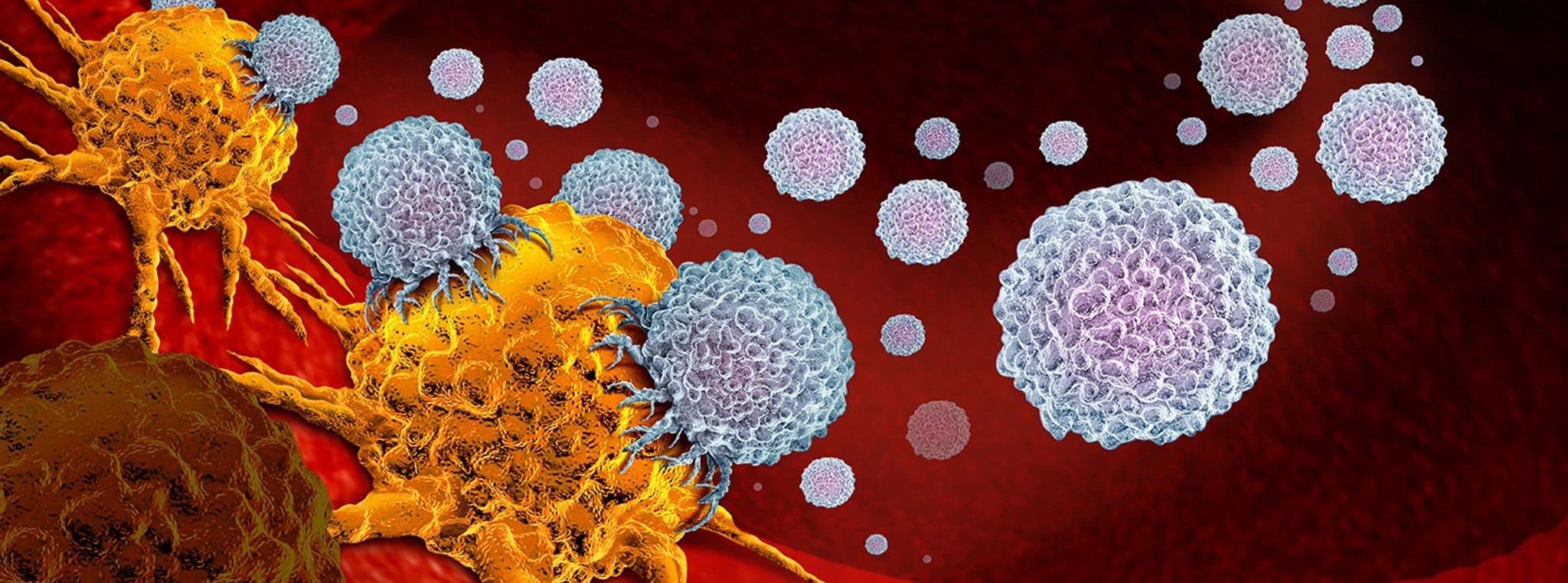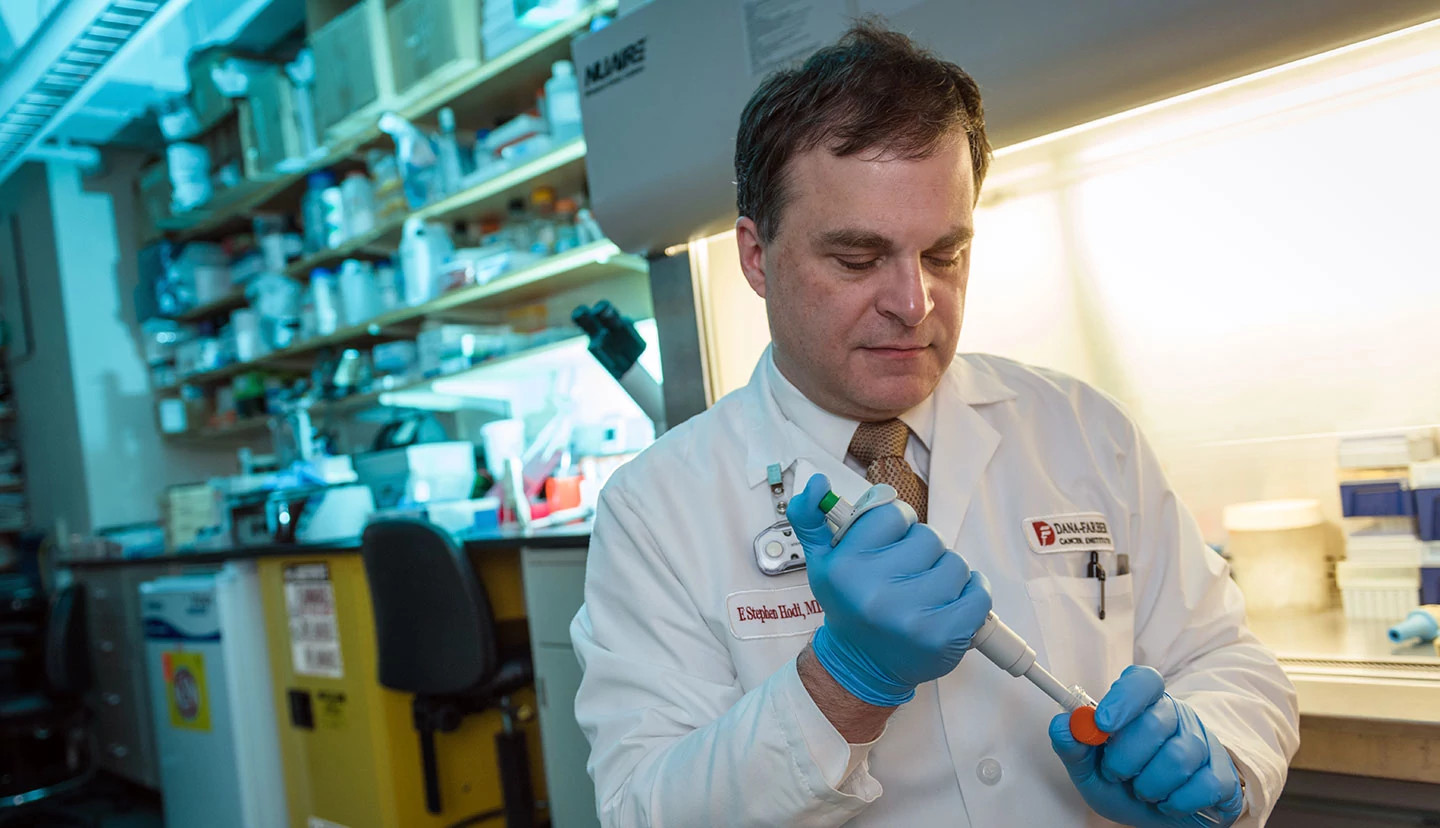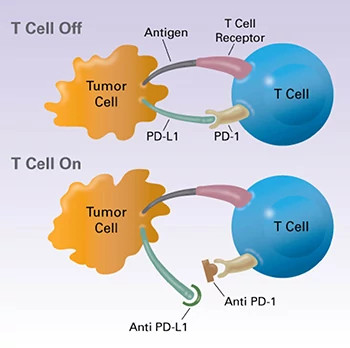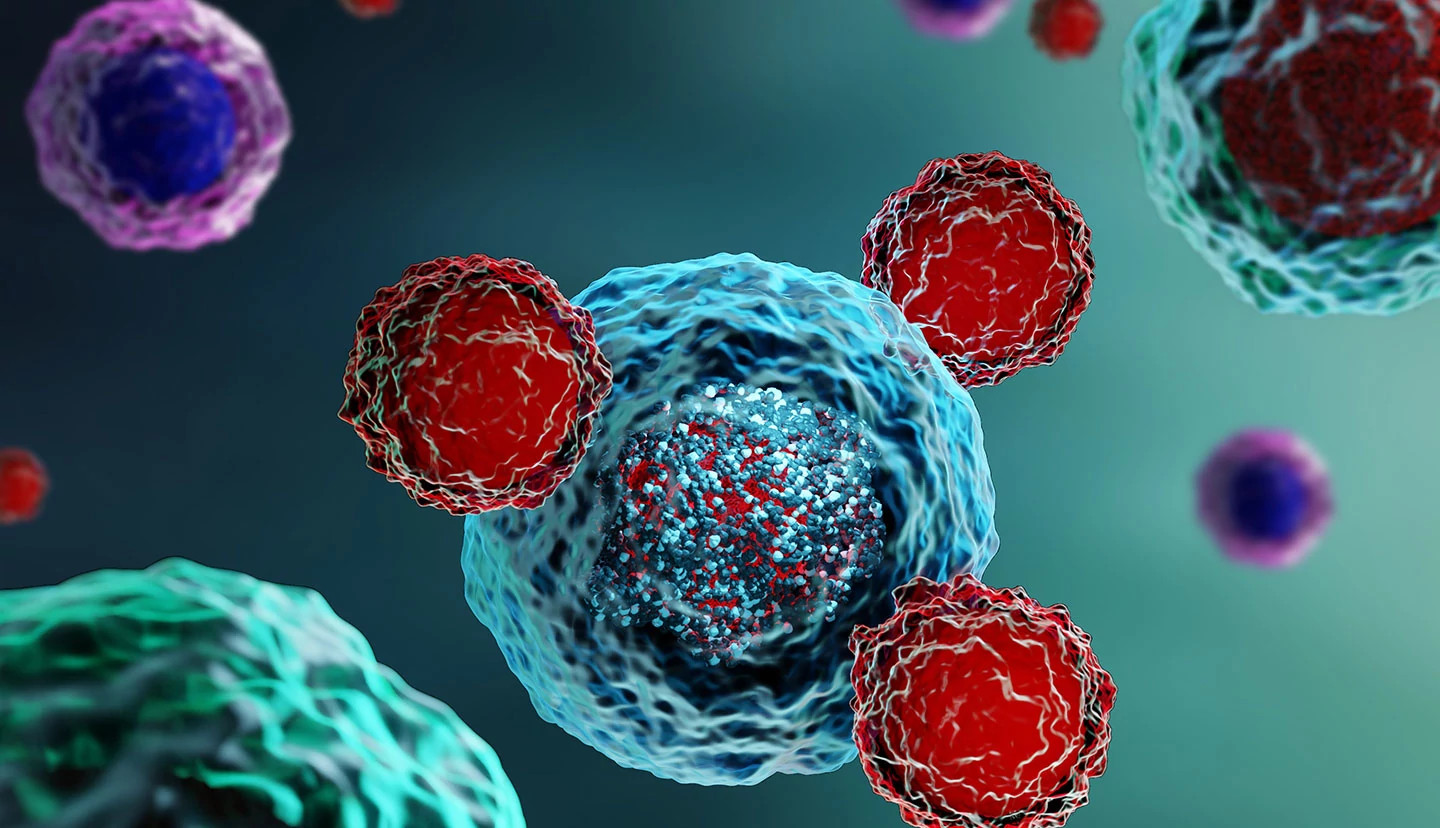
Combining Immunotherapy With Other Treatments Is Showing Great Promise Against a Variety of Cancers
September 07, 2022
Research
Leena Gandhi
Immunotherapy
Chemotherapy
By Robert Levy
Even heroes need partners. As researchers are discovering, immunotherapy — the avatar of a new approach to cancer treatment — often works better when paired with other types of therapy.
Some 5,000 clinical trials are currently under way in the United States combining immunotherapy and other treatments. And several such combinations have already become standard treatment for certain cancers, including a chemotherapy/immunotherapy regimen for some patients with non-small cell lung cancer.
That amount of clinical testing — and formal approvals of a still-novel approach to treatment — doesn't happen unless the approach is thought to have exceptional potential.
Expectations for this "plus" approach to immunotherapy are high because of what immunotherapies have accomplished on their own. For some cancers, immune-based therapies like checkpoint inhibitors and CAR T-cell therapies have redrawn the boundaries of what treatment can accomplish. In metastatic melanoma, a disease for which there were no approved treatments 15 years ago, immune checkpoint inhibitors consistently produce long-lasting remissions, and often cures, in more than 25% of patients. CAR T-cell therapies have produced full remissions in 90% of patients with acute lymphoblastic leukemia and up to 70% of those with chronic lymphocytic leukemia or non-Hodgkin lymphoma.
Results like those deserve to be extended. For although immunotherapy has worked magnificently for some patients with some cancers, its overall track record has been uneven. Some malignancies, such as pancreatic cancer, prostate cancer, and glioblastoma, have been largely resistant to single-agent immunotherapies. And even in some cancers where immunotherapy has scored its biggest successes, not all patients benefit (although those that do benefit often have thorough, long-lasting remissions).
We're seeing multiple examples of therapies that can enhance the activity of immunotherapies with generally manageable side effects. Around the world, scientists are working to broaden immunotherapy's range and reach — to enhance its effectiveness in cancers where it has already been successful, empower it against more types of cancer, and lengthen the remissions it triggers. This may involve developing new types of immunotherapies or upgrading ones already in use. Most often, however, it will involve pairing immunotherapy with other treatments.

"When you have therapies that individually can be effective against cancer, it makes sense to study whether combining them provides even greater benefits," says F. Stephen Hodi Jr., MD, director of Dana-Farber's Center for Immuno-Oncology, a hub of immunotherapy research at the Institute. "We're seeing multiple examples of therapies that can enhance the activity of immunotherapies with generally manageable side effects."
Clinical trials of such combinations are producing encouraging results, but the full potential of this approach probably won't be apparent for years. The number of ways immunotherapy can be combined with other agents is immense, and the task of determining which combinations work best for which patients under what conditions will take substantial amounts of time — and, likely, thousands more trials — to sort out. As is often the case in science, instances where particular combinations prove ineffective are apt to be as informative as those where combinations are successful.

An Army of Specialists
Cancer immunotherapy is a general term for treatments that harness the immune system to fight malignancies. The range of such treatments is broad because the immune system itself is diverse. Consisting of macrophages, monocytes, B cells, T cells, natural killer cells, myeloid cells, and other cell types, regulatory substances like chemokines and cytokines — as well as antigens, antibodies, and other components, each with their own roles and responsibilities — the immune system is a marvel of specialization. It is also highly dynamic, in constant touch with the rest of the body, mustering an attack on an invader or diseased cell when necessary, drawing back when the battle is over. Most immunotherapies target one or another of these elements, seeking to tweak the immune response to better target cancer.
The immune system presents a wealth of opportunities for treating cancer. 
The complexity of the immune system is one of its greatest assets in fighting disease — and poses one of the greatest challenges to researchers developing and studying immunotherapies. The variety of cells, proteins, and chemicals that make up the immune system represent countless targets for new drugs and other therapies. At the same time, the many moving parts of the system make it unlikely that any one immunotherapy agent could marshal the full force of the immune system's capabilities against cancer.
"The immune system presents a wealth of opportunities for treating cancer," says Patrick Ott, MD, PhD, director of clinical sciences at the Center for Immuno-Oncology. "Immune system cells, proteins, and signaling molecules all could potentially be modulated to strengthen the immune response. Finding combinations that can work within this complexity is a challenge – that's the focus of the field today."
Testing the Environment
Clues to single-agent immunotherapy's effectiveness in some cancers — and its less impressive results in others — can be found in a tumor's "immune microenvironment." Physicians and scientists traditionally thought of cancer in terms of the tumor cells that grow within a tissue, and traditional approaches to therapy — surgery, radiation therapy, chemotherapy, and targeted therapy — specifically targeted those cells.

But view a tumor sample under a microscope and it's clear there's more to cancer than tumor cells. Mixed in with the malignant cells in many tumors is an assortment of normal cells, blood cells, blood vessels, and immune system cells of various types and temperaments. Some of these immune cells are apt to be on the attack; others may simply be loitering. Still others may actually be reining in the immune attack.
From the standpoint of immunotherapy, each of these "ancillary" aspects of a tumor represents a potential ally in battling cancer. Immunotherapy agents aim to alter the immune microenvironment in ways that will rally its forces more effectively against tumors.
Current immunotherapies take a variety of approaches to this goal. Immune checkpoint inhibitors cause tumor cells to lower their guard against cancer-fighting T cells. Cancer vaccines use cells or parts of cells to spur an immune attack on cancer. CAR T cells are engineered to latch onto and destroy tumor cells. Monoclonal antibodies are lab-made versions of natural proteins that zero in on specific parts of cancer cells.
Even as they engage elements of the immune system, single-agent immunotherapies can't always rouse a sufficient response to cancer. A treatment that lowers the barriers to a T cell attack, for example, won't be successful if there aren't any T cells in the vicinity of a tumor. A therapy that stimulates T cells may have the unwanted effect of activating T cells whose job is to suppress an immune attack. Some cancers excel at not calling attention to themselves, essentially flying below the immune system's radar. Others mutate so they're able to jam the immune system's signaling circuits.
Combining immunotherapy with other types of treatment offers a way to overcome these obstacles. The history of cancer treatment offers ample evidence that two (or more) therapies can often accomplish what one alone cannot.
Some combinations rely on the power of addition: One treatment takes aim at a particular weakness of cancer cells, while its companion treatment targets another. Others — which are thought to hold the greatest potential — work synergistically, one therapy making the tumor more vulnerable to attack by the other.
Dana-Farber researchers are designing, leading, and participating in dozens of trials of immunotherapy in tandem with other treatments. Many of these trials are newly opened, some are well under way, some are closed and their data being analyzed, and some are in the planning stages. Together they offer a mosaic of the variety of combinations being studied and an early inkling of their effectiveness.
Here is a sampling of such trials at Dana-Farber, illustrating the range of approaches currently being explored.
Immunotherapy Plus Chemotherapy
It was initially thought that chemotherapy and immunotherapy would make a good couple because the killing of tumor cells by chemotherapy can lead to the exposure of substances called neoantigens. The disclosure of these structures, which arise from mutations and other changes within cancer cells, can spark an immune attack on the cells. Research has shown that other, more powerful, mechanisms are also at work.

Leena Gandhi, MD, PhD, director of Dana-Farber's Center for Cancer Therapeutic Innovation, explains: "Many chemotherapies cause tumor cells to lyse, or disintegrate, which exposes neoantigens [which can be recognized as 'foreign' by the immune system]. The immune system responds by expanding the population of T cells that recognize those antigens. Some chemotherapy agents can also trigger an increase in inflammatory factors and other stress-induced changes in the tumor microenvironment during cell killing, which cause T cells to proliferate and become active against cancer."
Gandhi led a pivotal phase 3 clinical trial of chemotherapy and pembrolizumab — a checkpoint inhibitor targeting the PD-L1 protein on tumor cells — in patients with non-small cell lung cancer, the most common form of lung cancer. Prior to the trial, pembrolizumab was generally reserved for patients whose tumors were high in PD-L1. The trial showed, however, that the combination significantly improved survival in all patients, regardless of whether their tumors tested positive for PD-L1. "That really changed the standard of care for this form of lung cancer," Gandhi states, "and became the gateway for many other chemotherapy combinations in many other kinds of cancers."


Immunotherapy Plus Targeted Therapies
Combinations of targeted drugs and immunotherapies represent a doubly personalized form of treatment: the former tackle abnormal or overabundant proteins on tumor cells while the latter steer the immune system to the tumor. Glenn Hanna, MD, is heading a trial in which patients with head and neck cancer first receive an immune checkpoint inhibitor followed by chemotherapy and a drug that targets the PI3K protein, which is overactive in many cancer cells.
"The idea is that the effects of immunotherapy may continue after treatment ends, which we can capitalize on with chemotherapy and the targeted agent," Hanna remarks. "We're about halfway to full enrollment in the trial, and we've seen some promising activity with the combination already."
Immunotherapy Plus Anti-Angiogenic Therapies
In the early 2010s, Glenn Dranoff, MD, then of Dana-Farber, now at Novartis, was examining tumor samples from patients who had been treated with checkpoint inhibitors when he found evidence that blood vessels within the tumors had been attacked by the immune system. Intriguingly, it appeared that normal blood vessels were left unscathed.
"We began to look at how the immune system might be recognizing blood vessels specifically feeding tumors," says Hodi. "We found that, following checkpoint inhibition, the immune system began making antibodies against factors that stimulate the growth of these vessels."

Hodi led a trial of a checkpoint inhibitor plus an anti-angiogenic drug, which showed some synergy. "Others jumped on this work," he says, and the combination is now approved as a frontline treatment for kidney cancer, endometrial cancer, and hepatocellular cancer (the most common type of liver cancer) and has shown promise against lung cancer and melanoma.
A series of trials led by Toni Choueiri, MD, director of the Lank Center for Genitourinary Oncology at Dana-Farber, was key in demonstrating the two-drug therapy's effectiveness in kidney cancer. "We combined an anti-angiogenic drug with a checkpoint blocker and compared them to an anti-angiogenic drug alone and found a combination conferred a significant survival advantage," Choueiri says. His team is currently leading trials of a three-drug regimen — an angiogenic inhibitor, checkpoint blocker, and targeted drug — in patients with metastatic kidney cancer.
Immunotherapy Plus Immunotherapy (Plus More Immunotherapy)

The promise of immunotherapy initially seemed to bypass patients with pancreatic cancer. The reason is as clear as the cancer's image under a microscope. "If you look inside a pancreas tumor, everything about it is inhospitable to immune cells that can attack the cancer," says James Cleary, MD, PhD. "It's a very, very difficult place to mount a productive immune response."
In studies with animal models, Dana-Farber's William Freed-Pastor, MD, PhD, explored whether a checkpoint inhibitor combined with one immunostimulatory molecule would work better than a checkpoint inhibitor alone. They did not. He then tested a checkpoint inhibitor in combination with two immunostimulatory molecules, saw some "really encouraging responses," Cleary says. The results provided the impetus for a clinical trial, expected to open this fall, of the combination in patients.
Immunotherapy Plus Surgery
Using chemotherapy to shrink tumors prior to surgery is a common approach in treating many solid tumors. A trial led by Dana-Farber's Jonathan Schoenfeld, MD, MPH, suggests an immunotherapy-first approach can be highly effective in patients with cancers of the oral cavity, which often don't respond well to standard therapy of surgery, chemotherapy, and radiation therapy.
In the trial, 29 patients were treated with either one or two checkpoint-inhibiting drugs, followed by surgery within a week of their final dose of immunotherapy. The researchers found that even among patients who received a single drug, more than half had some shrinkage of their tumors. A few had more than 90% shrinkage and one patient's tumor vanished. An average of 14 months after treatment, more than 85% of patients were alive with no worsening of their cancer.
In a follow-up study led by Kai Wucherpfennig, MD, PhD, researchers identified biomarkers — the presence of certain types of T cells in the blood — that indicate which patients are likely to have the best response to this approach to treatment.
A Matter of Timing
Beyond determining which therapies make the best partners, researchers are also grappling with questions of sequencing: should one agent be given before the other, or do they work better if given simultaneously? "There are really important timing considerations that are being examined in many trials of combination therapies," Gandhi says. "In cases where we haven't seen positive results of combinations, we need to ask whether timing issues are playing a role."
Researchers are also sensitive to the fact that in combining agents, two is not always more — more effective, more beneficial — than one; in some cases, two can be less than one. "We know that immediately following radiation therapy, for example, the immune microenvironment often fills with cells that suppress the immune response," Gandhi remarks. "Some chemotherapy agents have that effect as well."
Even with these challenges, "We are definitely seeing early signs of promise," Gandhi continues. "Just as tumors are currently profiled for molecular abnormalities that are susceptible to targeted therapies, we hope that it will become routine to analyze tumors microenvironment to determine which immunotherapies, alone or in combination, are likely to work best in each patient."